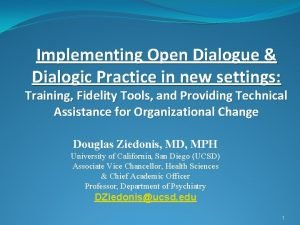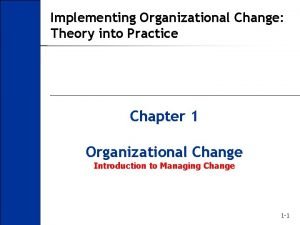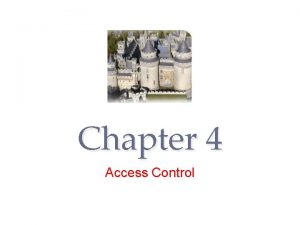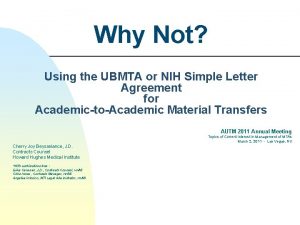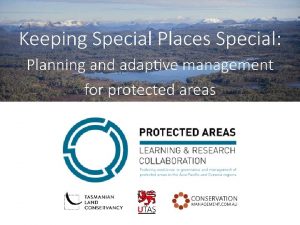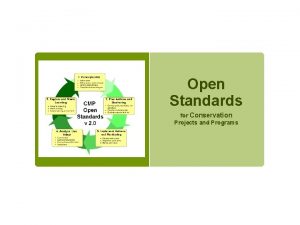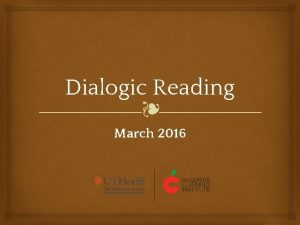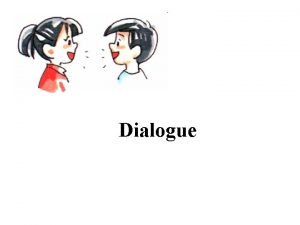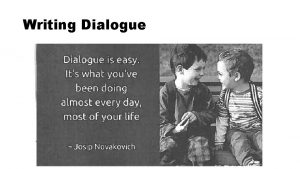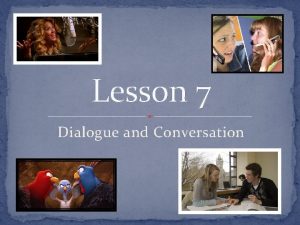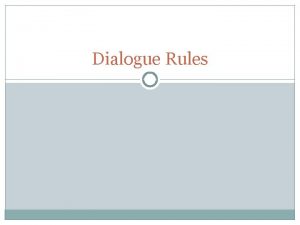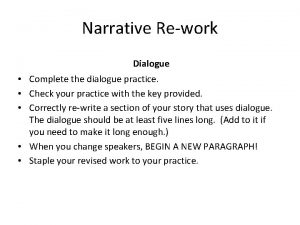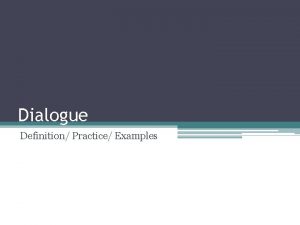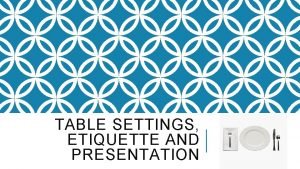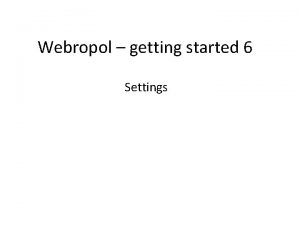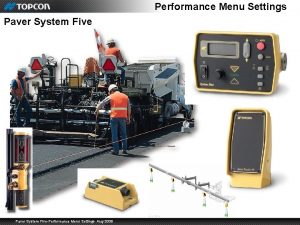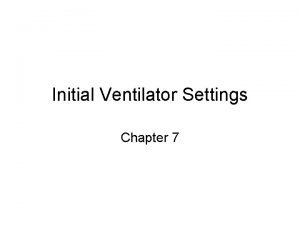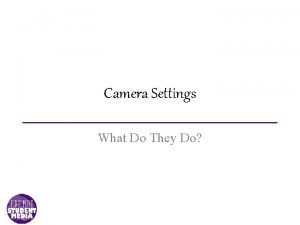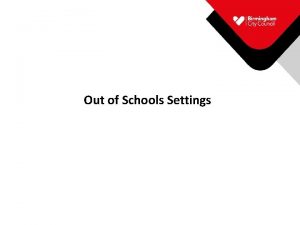Implementing Open Dialogue Dialogic Practice in new settings
































- Slides: 32

Implementing Open Dialogue & Dialogic Practice in new settings: Training, Fidelity Tools, and Providing Technical Assistance for Organizational Change Douglas Ziedonis, MD, MPH University of California, San Diego (UCSD) Associate Vice Chancellor, Health Sciences & Chief Academic Officer Professor, Department of Psychiatry DZiedonis@ucsd. edu 1

Many Others to Thank �Mary Olson & Jaakko Seikkula �UC San Diego & University of San Diego colleagues & UCSD Open Dialogue Program �Former UMass Open Dialogue team �Finish & Norwegian Teams �International Consortium and Partners �USA colleagues, including Advocates and Emory University �Foundation for Excellence in Mental Health Care 2

SEVEN PRINCIPLES FOR ORGANIZING OPEN DIALOGUES IN SOCIAL NETWORKS �IMMEDIATE HELP �SOCIAL NETWORK PERSPECTIVE �FLEXIBILITY AND MOBILITY �RESPONSIBILITY �PSYCHOLOGICAL CONTINUITY �TOLERANCE OF UNCERTAINTY �DIALOGISM

Variations: USA based projects � University of California San Diego � UCSD Health / USD � Global Partnerships – UK, Italy, Denmark, Latvia, Japan, China, Norway, etc � Emory University / Grady Health Care � Advocates Framingham Massachusetts � New York: Parachute project � Vermont State – DMH � Pilot implementation at Howard Center, Burlington � Pilot training by Collaborative Networks Approach (CNA) by Vermont Cooperative for Practice Improvement & Innovation � Boston programs

First USA OD Pilot Study Published � A one-year study of the feasibility of implementing an outpatient program based on OD principles � Serving 16 young people aged 14– 35 years experiencing psychosis

USA West Coast – Open Dialogue 6

Current UCSD Study: Develop Implementation and Fidelity Assessment Tools & Pilot Studies � Develop Dialogic Practice (DP) Fidelity Manual & Fidelity Tools: � 12 Key Elements � Develop OD Org Change Guide & Fidelity Tool: � 10 Organizational Criteria � Adapt Addressing Problems Through Organizational Change (APTOC) � Enhancing Recovery Through Organizational Change (ERTOC) � Method for adapting local culture & integrating OD/ DP 7

UCSD Pilot Studies � Behavioral Therapy Development Studies & Implementation Science � Pilot Test implementing OD & DP in USA & Globally � Learn to Provide Technical Assistance � Implement the Tools and Learn � Mixed Methods Research � Assess Feasibility & Outcomes � Change Focus Group Process � Culture of our Group 8

Why create the criteria and assess fidelity? �Helps with training – especially in the beginning �Helps with supervising and monitoring best practice �Expected in research on behavioral therapies – Therapy Development Stage, Fidelity, Therapist Selection, Study Design, Theoretical Framework, etc �Stage 1 A: Manual, Fidelity Measures, Training materials, and demonstration of feasibility to implement the approach. �Helps in being labeled “evidence based practice” �SAMHSA’s National Registry of Evidence-based Programs and Practices (NREPP) promotes the adoption of scientifically established behavioral health interventions. �Insurance company / Federal Agency Support 9

Good Clinical Practice / Need Adaptive �Dialogic practice is a specific therapeutic conversation approach that occurs in network meetings and many of the ingredients are found in other approaches such as deep listening, being in the moment, and using open ended questions. �Good clinical practice is expected which may vary according to health care system, country, discipline, funding agency, and specific organization. �Developing a therapeutic alliance through empathy, respect and listening is considered good clinical practice. �Dialogic Practice is need adaptive which allows for the integration of a range of content and approaches to the core methods. 10

Open Dialogue Research: Dialogic Practice Fidelity Rating Manual �UC San Diego 11

DP Fidelity Rating Manual � developed to evaluate network meetings using Dialogic Practice � two fidelity assessment tools used in rating recording 1. “Classifying Clinicians Utterances: Dialogic Practice Fidelity Rating Tool”; � 2. “Final Scoring for Network Meeting: Dialogic Practice Fidelity Rating Tool. ” � � For researchers, clinicians and educators as a self-guide and training tool. � inter-rater reliability is likely to be assessed as part of the study. � need to create anchoring points / benchmarks for the adherence items and to provide more clarity for the reviewers on how to actually rate a recording. � Version 1. 0 of the Dialogic Practice Fidelity Rating Manual (Feb 2018). � We assume that this coding manual will evolve with additional experience, new research findings, and the need for adaptation to new settings. 12

Fidelity Rating Tools �The fidelity rating tools record the rater’s ratings of clinician utterances. �The specific tool has had great input from raters in the field �Ours follows a logic model algorithm that seems to work well for our raters in collecting the information. �We look forward to hearing of more experiences in rating recordings. �Please contact DZiedonis@UCSD. edu if you have additional questions, feedback from implementing, or other comments. 13

Training Raters �Training on OD and DP – including key elements �Read coding manual �Review tools �Listen to several complete recordings �Assess inter-rater reliability with more experienced raters and supervisors �SELECTION of Coders 14

Steps in Rating a Recording Permission of Participants Code the Clinician Utterances – Use flow sheet Timestamps help – review / clarify sections Second step – rate the Key elements (10 in session) Complete the evaluation 3 questions to determine if session is DP Network Meeting 6. Review with clinical team during training 1. 2. 3. 4. 5. 15

What is an utterance? �Key – assessing monologic versus dialogic clinician utterances �Multiple utterances in an utterance �Noting silences 16

The 12 Key Elements of Dialogic Practice in Open Dialogue Two Structural Elements 1. Two (or More) Therapists in the Team Meeting 2. Participation of Family / Individual’s Support Network Ten Clinician Dialogue Elements 3. Using Open-Ended Questions 4. Responding To Clients’ Utterances 5. Emphasizing the Present Moment 6. Eliciting Multiple Viewpoints 7. Use of a Relational Focus in the Dialogue 8. Responding to Problem Discourse or Behavior in a Matter-of-Fact Style and Attentive to Meanings 9. Emphasizing the Clients’ Own Words and Stories, Not Symptoms 10. Conversation Amongst Professionals (Reflections) in Meeting 11. Being Transparent 12. Tolerating Uncertainty (Olson, Seikkula, and Ziedonis, 2014)17

What’s acceptable level of each element? How score? B. 12 Key elements of fidelity 1 – Not at acceptable level 2 - Acceptable 3 Good 4 Excellent 18

How decide if the session was a DP meeting? C. Overall quality Yes 1. Was the proportion of dialogic statements versus monologic statements - at least twothirds (0. 67)? 2. Were at least 8 of the 10 fidelity items in Section B at the level of “Acceptable” or higher? 3. Were there fewer than two instances of patronizing or disrespectful statements from red boxes in Section A? No 19

20

21

22

1. Responding to Client “Utterances” (verbal and non-verbal communication) This element includes components of (a) responsive listening and (b) allowing for and tolerating silences in the conversation. In creating a summary score for this element to complete the Dialogic Practice Fidelity Rating Tool, the most important thing is to determine whether this element was acceptable or not: you may average across (a) and (b) but if either was rated as 1 (namely, the lowest level), rate this element as unacceptable in the Dialogic Practice Fidelity Rating Tool. Of note, the third aspect of “utterances” is the non-verbal communication sub-item. Since most raters will be listening to an audio recording only, they cannot rate nonverbal attunement and therefore we do not include this in the rating process. This is an important item in the training process, so we note this here. If the rater is viewing video, the rater might see the clinician mirroring the client’s body language, but this will not be rated in this version. Raters may hear on occasion that a clinician / therapist / facilitator will verbalize what they see non-verbally - this is recorded in the responsive listening sub-item. For example, a clinician might say to a network member: “I notice your tears. What are they saying? ” 23

a. Allowing for and Tolerating Silences in the Conversation Is there tolerance for silence? Were there pauses where silences were allowed? It’s important to acknowledge that cultures have different norms about length of time of the silences in conversations. Uncertainty may be present in multiple topics and multiple places in the conversation. Rate using the following anchors: 1 = Clinician interrupts frequently 2 = Clinician doesn’t interrupt, but responds hastily after network member stops speaking. 3 = Some spaces where clinician appears to wait (more than 3 seconds). No new unrelated comment by clinician. 4 = Clinician allows for silences. May note calmer conversation. Person at the center of concern may reveal deeper emotional topic. 24

a. Responsive Listening: This includes listening to and repeating client’s words. This could include verbalizing the non-verbal behaviors that the clinician sees. For example, a clinician noted to a family member that “you smiled when you shared your story”. Clients may offer a whole new piece of the puzzle with such reflections and it may make the situation more understandable. Rate using the following anchors: 1 = Clinician completely disregarded client’s utterances. 2 = Clinician demonstrated some use of skills such as good listening and an ability to repeat the words of the client. 3 = Clinician generally exhibited responsive listening and, when appropriate, usually repeated clients words. Client appeared more engaged as demonstrated by expression of some new dialogue. 4 = Clinician fully engaged and responsive to person at the center of concern / family which leads to enhanced dialogue 25

10 Organizational Criteria for Open Dialogue *in Agencies and Programs 1. Patient and Support Network Centered Care Approach 2. Respect, Authenticity & Collaboration (leadership support & values) 3. Clinical teams (with multiple providers) meet routinely with patient/family/support network in collaborative meetings for making major decisions 4. Staff is well trained in respectful communication, dialogic practice and family/network engagement 5. Create a welcoming environment with a focus on customer experience 6. Provide and connect services in clinical and community settings 7. Practice the 12 Key Elements of Dialogic Practice including tolerating uncertainty and promoting dialogue 8. Provide immediate support and access to needed services 9. Shared decision-making process 10. Use Open Dialogue as a mindful way of being Copyright 2015

Enhancing Recovery Through Organizational Change (ERTOC) � Person & Family, Staff, & Environmental Goals � Change Culture to Support EBT Implementation � Organizational Change Strategies � 3 Phases: Plan, Implement, & Sustain � 10 Step Model � Leadership: Vision and Support � Communication � Monitoring Change Process & Outcomes � Develop a “Dashboard’ of key outcomes � QI Technical Assistance & Training

Enhancing Recovery Through Organizational Change (ERTOC) �Recovery Oriented Philosophy and Approach needed in the United States �Change Management structure �Technical Assistance Support �Way to change culture to support OD philosophy of life / value system �Needed to find a way to bring to the USA and hope to maintain the core principle and values 28

Step 3: Organizational Readiness �Person at Center of Concern & Family / Support Network - level: � Chart reviews � Current treatment & specialists � Peer specialist’s perspective �Staff-level: � attitudes, skills, and knowledge � Training needs & how work together �Environmental-level: � Do Walk-Around and meet, look and listen � Policies, Brochures & Signage

Survey of Clinicians and Leaders Implementing Open Dialogue Questions for those doing OD / DP �Why did you adopt OD / DP? �How did you adapt OD / DP? �What did you change? �Your organization, a program, or care for some cases? �What are the changes now in practice and outcomes? �How link with education, employment, housing, etc? �What funding / reallocation of resources? �What were the barriers / facilitators? �What were the steps and big goals? �How engage physicians and peer support? �How sustain change? �What are your lessons learned? 30

Adaptations – Great Variations �Vary by Resources / Finances �Vary by Structure / Organization �Vary by Treatment Orientation / Values �Vary by Culture – of Country, Agency, & Programs �Vary by Politics �Vary by Role of Peers and Physicians 31

Thank You Questions? 32
 Dialogic practice definition
Dialogic practice definition Dialogic feedback cycle
Dialogic feedback cycle Implementing organizational change theory into practice
Implementing organizational change theory into practice Congratulate dialogue
Congratulate dialogue Open innovation open science open to the world
Open innovation open science open to the world Hrd program implementation and evaluation
Hrd program implementation and evaluation Management issues central to strategy implementation
Management issues central to strategy implementation Strategic management chapter 7
Strategic management chapter 7 Implementing strategies: management and operations issues
Implementing strategies: management and operations issues Setting prices and implementing revenue management
Setting prices and implementing revenue management Implementing merchandise plans
Implementing merchandise plans Designing and implementing branding strategies
Designing and implementing branding strategies Designing and implementing brand architecture strategies
Designing and implementing brand architecture strategies What is documentation portfolio
What is documentation portfolio Crm vision statement example
Crm vision statement example Qsen teamwork and collaboration examples
Qsen teamwork and collaboration examples Challenges of implementing predictive analytics
Challenges of implementing predictive analytics Implementing organizational change spector
Implementing organizational change spector Finance and accounting issues in strategy implementation
Finance and accounting issues in strategy implementation Is the traditional method of implementing access control
Is the traditional method of implementing access control Problems in implementing portfolio management
Problems in implementing portfolio management Matching structure with strategy
Matching structure with strategy Nivea brand architecture
Nivea brand architecture Nfpa 1600 standard
Nfpa 1600 standard Autm ubmta
Autm ubmta Nfpa 1600 business continuity programs
Nfpa 1600 business continuity programs Stateful firewall
Stateful firewall Ch 7
Ch 7 On delay and off delay timer symbol
On delay and off delay timer symbol Open hearts open hands
Open hearts open hands Open standards for the practice of conservation
Open standards for the practice of conservation Open standards for conservation
Open standards for conservation Myeplg
Myeplg
